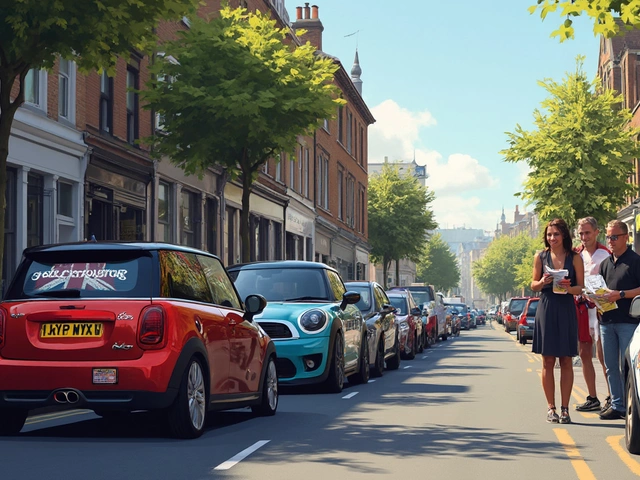Standard headlights have come a long way since those old yellow halogens. If you’ve noticed brighter, whiter lights on newer cars these days, they’re almost always LEDs. And you’re probably asking yourself: is it really worth ditching your factory bulbs for something LED?
The short version: LEDs promise way better visibility, a whiter light, and they tend to last way longer than what you probably have now. But it’s not all sunshine and unicorns—there are a few things you’ll want to think about before making the switch.
Here’s something a lot of folks don’t realize: swapping in LEDs isn’t just about style. Sure, they look snazzy, but they also cut down on the strain during nighttime driving. Road signs pop, and those random country roads suddenly don’t feel so pitch black. Speaking from experience, I honestly worry less when Rowan’s riding with me at night since putting in LEDs. Better lighting just feels safer, simple as that.
- Why People Upgrade to LED
- How LEDs Compare to Halogen and HID
- The Downsides No One Talks About
- What to Know Before You Swap
Why People Upgrade to LED
If you’re hearing all the buzz about LED headlights, there’s a reason—they fix a lot of the stuff that bugs people about old-school bulbs. Let’s get real: factory halogen bulbs are dim, yellow, burn out often, and just can’t keep up with today’s driving conditions.
The biggest reason folks swap to LEDs is pure and simple: visibility. LEDs throw out a brighter, crisp white beam that actually lets you see farther down the road. No more guessing if that’s a deer up ahead or a sign. A ton of drivers say the road just looks clearer and it’s easier to spot people or animals crossing instead of getting surprised in the dark.
- Longer lifespan: Most LED headlight bulbs last about 20,000 hours, compared to maybe 1,000 for typical halogens. That means way fewer trips to the store and less hassle swapping bulbs—especially on cars where that means scraped knuckles or removing half the front grill.
- The energy draw is way lower. LEDs sip battery juice compared to traditional bulbs, which is handy if you run other electronics (heated seats, stereo, charging your phone, you name it).
- LEDs run cooler. Less heat means less risk of melting your wires or frying your plastic housings—something a lot of folks don’t think about until it’s too late.
- Modern look: Not gonna lie, it just looks better. Swapping to LEDs can give even an older car that sharp, up-to-date vibe without paying dealership upgrade fees.
Here’s a quick comparison so you can see why people are jumping ship from halogen to LEDs:
| Type | Average Lifespan (hours) | Brightness (lumens) | Power Use (watts) |
|---|---|---|---|
| Halogen | 1,000 | 900-1,500 | 55-65 |
| LED Headlights | 20,000 | 3,000-4,000 | 30-40 |
| HID | 2,000-3,000 | 3,000-3,500 | 35-45 |
Notice the jump in both lifespan and brightness. That’s not hype—that’s real numbers. Plus, lots of parents (including me) appreciate that you can put them in once and not stress about replacing them for years, even with lots of night driving.
How LEDs Compare to Halogen and HID
If you're stuck between what kind of headlights to go for, it usually comes down to halogen, HID, or LED headlights. Each one brings something different to the table. Let's break down what really matters when you're making the choice.
Halogen bulbs are what most cars have rolled out with for decades. They're cheap and easy to find. But they've got a few downsides—mostly, they're pretty dim (that yellowish hue just doesn’t cut it on pitch-black roads) and they burn out faster than you’d like. A standard halogen bulb lasts about 500–1,000 hours.
Next up: HID (high-intensity discharge) bulbs. These are a step up. If you've seen those cars with blue-ish headlights, that's usually HID. They’re a whole lot brighter than halogen and throw light further. But they can take a few seconds to hit full brightness once you flip them on. Also, if they're not aimed just right, they can blind oncoming traffic and get you flashed a lot by unhappy drivers.
Now, LEDs are the game-changer here. These things reach full brightness instantly. They use less power, so you’re not stressing your car’s electrical system, and they create a whiter, cleaner light that helps you see things further down the road. LEDs usually outlast both halogen and HID bulbs, with some brands claiming their bulbs can go for 20,000+ hours. I swapped halogens for LEDs in my own SUV two years ago and haven’t had to touch them since.
| Type | Brightness (Lumens) | Color Temp (Kelvin) | Lifespan (Hours) | Energy Use |
|---|---|---|---|---|
| Halogen | 700–1,200 | 3,200–4,300K (Yellow-White) | 500–1,000 | High |
| HID | 3,000–5,000 | 4,000–6,000K (White-Blue) | 2,000–5,000 | Medium |
| LED | 4,000–6,000 | 5,000–6,500K (White) | 15,000–30,000 | Low |
Here’s a quick look at where each type really shines (or doesn’t):
- Halogen: Cheap, easy to replace, but not much punch in terms of brightness or lifespan.
- HID: Way brighter, looks modern, but can be tricky on older vehicles without projector lenses.
- LED: Best for brightness and lifespan, saves you money long term, but can cost more upfront.
If you’re driving a lot at night or outside the city, LEDs really do make a huge difference. Plus, you’ll probably never have to deal with swapping out burnt bulbs on a rainy night. It’s just one less hassle—trust me, after trying all three over the years, I’m not going back.

The Downsides No One Talks About
So, LED headlights sound like a no-brainer, right? But before you rush to buy a pack online, you should know about the stuff that doesn’t usually show up in glossy ads. Not every upgrade is smooth, and some people hit issues right from the start.
First, not all cars are a perfect fit for LED swaps. Lots of older vehicles use reflector-style housings that were made for halogen bulbs. Stick an LED in there, and you might not get focused light. What happens? The beam pattern can turn sloppy, sometimes blinding oncoming drivers or leaving dark spots in front of your hood. That’s not just annoying—it can get you pulled over in some states.
Next up, LEDs aren’t exactly plug-and-play for everyone. Some cars will throw dashboard errors or flicker the new lights because the electrical system expects the lower wattage of halogens. You might need extra gadgets (like resistors or decoders) to fix this, and those can be hit-or-miss depending on your make and model.
If you live somewhere cold, here’s another curveball: LEDs don’t get hot like halogens. That sounds good, but in snowy weather, the lens cover can actually ice over instead of melting snow off like with good old halogen bulbs. No warm bulbs means you may have to scrape your headlights more often—nobody likes that at 6am.
And while manufacturers talk up the long life of LEDs (they can last up to 30,000 hours), cheaper bulbs aren’t always built to that standard. Going with bargain brands from online marketplaces? You might find they start to dim or flicker within a year. Here’s a quick look at common LED vs. halogen stats:
| Type | Average Lifespan | Heat Output | Common Issues |
|---|---|---|---|
| LED headlights | 20,000-30,000 hours | Low | Beam pattern, compatibility, icing over |
| Halogen bulbs | 500-1,000 hours | High | Short lifespan, yellower color |
One last tip: some states are cracking down on illegal LED conversions. It’s not that LEDs are banned, but aftermarket kits sometimes don’t meet DOT rules or local standards. I’ve read stories of people failing inspections or even getting tickets just because their headlights were too bright or aimed too high.
- Check your owner’s manual and state laws before upgrading.
- Stick to reputable brands that have actual DOT approval.
- If you’re unsure, get a pro to install and aim your new bulbs.
This stuff isn’t meant to scare you off, but knowing what can go wrong makes for a smoother upgrade. Better to find out now than while getting a ticket or squinting through a snowy drive.
What to Know Before You Swap
Before you go all in on those bright new bulbs, there's a lot more to the swap than just unscrewing the old ones and popping in something shiny. Here’s what you really need to have in mind if you’re planning to switch up to LED headlights:
- Fitment matters: LED bulbs are not universal. Some cars just don’t play nice with aftermarket LEDs. Double-check your vehicle’s headlight housing type and space—some LEDs are fatter and may not fit. You’ll want to check your car’s manual or head to a bulb finder online before you order.
- Beam pattern can make or break it: The point of headlights is to light up the road—not blind everyone else. Cheap LEDs sometimes scatter the beam, causing glare. If your bulb’s pattern isn’t right, you’re going to annoy every oncoming driver. Stick with reputable brands that show real beam pattern tests.
- Plug and play? Sometimes, but not always: Some LEDs drop right in and work. Others need special adapters or even an anti-flicker harness because your car’s computer system wasn’t built for LEDs. That means you might have to buy more than just the bulb.
- Legal stuff is no joke: In some states or countries, aftermarket LEDs in halogen housings are technically illegal. If you get stopped and your headlights don’t meet the rules, you could get a ticket or fail inspection. Always check your local laws—weird, but important.
To help compare what you get with different headlights, here’s a simple stats breakdown. You can see why so many folks are tempted to switch:
| Type | Average Lifespan (hours) | Light Color (Kelvin) | Power Use (Watts) |
|---|---|---|---|
| Halogen | 500–1,000 | 3,000–4,200K (yellowish) | 55 |
| LED | 10,000–30,000 | 5,000–6,500K (white/blueish) | 15–25 |
| HID | 2,000–8,000 | 4,500–6,000K (white/blueish) | 35 |
If you want the swap to go smoothly, here’s a few extra tips to make the process easier:
- Order from a brand with a clear return policy. Seriously—sometimes even "guaranteed fit" bulbs don’t fit.
- Look for CANbus compatibility if your car is newer, so you don’t end up with annoying dashboard warnings.
- Watch a couple YouTube install videos for your exact car model first. Saves a bunch of headache and shows you if extra tools are needed.
Bottom line: Upgrading headlights is a smart move, but a little prep work goes a long way. The right LED can be a game-changer; the wrong one can just give you a headache.






